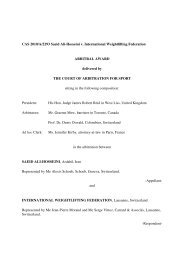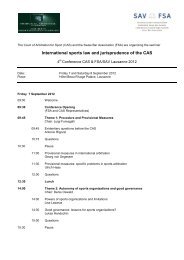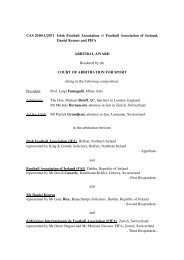(CAS) Bulletin - Tribunal Arbitral du Sport / TAS
(CAS) Bulletin - Tribunal Arbitral du Sport / TAS
(CAS) Bulletin - Tribunal Arbitral du Sport / TAS
Create successful ePaper yourself
Turn your PDF publications into a flip-book with our unique Google optimized e-Paper software.
pursuant to EC Regulation 2391-2000 would be<br />
0.0042%.<br />
This percentage would have to be further re<strong>du</strong>ced to<br />
take into account the fact that the samples recorded<br />
in the EU 2008 Report (both the Suspect and the<br />
Targeted Samples) are not random but pre-selected<br />
to be more likely to pro<strong>du</strong>ce a non-compliant result.<br />
Indeed, one should also consider that the presence<br />
of clenbuterol within livestock at a farm would not<br />
necessarily result in contaminated meat after the<br />
slaughter of such livestock (i.e. if the animals are<br />
slaughtered after the clenbuterol has exited their<br />
system); the “suspect sample” case of clenbuterol in<br />
Italy was in fact taken at a farm and based therefore<br />
on living animals. The percentage of contaminated<br />
meat available at retail outlets (e.g. butchers) would<br />
therefore be smaller still. The actual percentage<br />
possibility of a piece of bovine meat bought at a retail<br />
outlet in Europe being contaminated with clenbuterol<br />
is therefore according to WADA’s submissions and<br />
based on the most recently published European<br />
statistics, substantially less than the level mentioned<br />
above.<br />
An analysis of equivalent reports (to the EU 2008<br />
Report) from previous years reveals that Spain has<br />
had just one positive case of clenbuterol since (and<br />
including) 2004, such case occurring in 2006. A<br />
summary analysis of these reports from previous<br />
years also reveals a marked decreasing trend in terms<br />
of beta-agonist contamination in targeted bovine<br />
samples. The following percentages of such samples<br />
were positive for any beta-agonist (as opposed to<br />
just clenbuterol): 2005: 0,08%, 2006: 0,06%, 2007:<br />
0,01%, 2008: less than 0,009%. It is therefore logical<br />
to assume that this clear trend continued in 2009 and<br />
2010.<br />
According to WADA, the above statistics alone are<br />
suffi cient to conclude that the possibility that a given<br />
piece of meat bought in Europe is contaminated with<br />
clenbuterol is vanishingly thin.<br />
The statistics at regional level in Spain confi rm that<br />
clenbuterol contamination is extremely unlikely in the<br />
relevant regions of the Basque Country and Castilla y<br />
Léon. In Castilla y Léon, offi cial fi gures of the Health<br />
Ministry of the “ Junta de Castilla y Léon ” reveal that<br />
between 2006 and 2010, 7,742 bovine samples were<br />
taken specifi cally to detect beta-agonists and not a<br />
single positive of clenbuterol has occurred <strong>du</strong>ring<br />
this period. Between 2006 and 2009 (inclusive), 396<br />
bovine samples were analysed for beta-agonists,<br />
again without a single positive clenbuterol fi nding.<br />
WADA reminded the Panel that it is of course not<br />
able (nor required) to prove (statistically or otherwise)<br />
that there is not a single piece of contaminated meat<br />
in Europe, Spain or the Basque Country.<br />
WADA is supported in its conclusions by Dr Martin-<br />
Pliego López, as he concludes that the probability of<br />
a bovine animal being contaminated with clenbuterol<br />
has been zero or almost zero in Spain <strong>du</strong>ring the last<br />
few years.<br />
In his written submissions, Mr Contador contends<br />
that the arguments used by WADA are erroneous<br />
and misguided. The EU 2008 Report contains<br />
severe limitations and the dangers of relying on it are<br />
outlined in detail in a report prepared by Prof. Sheila<br />
Bird:<br />
a) The “analysis at EU-level tacitly assumes – but does<br />
not evidence – that the member states’ random sampling<br />
plans are all of the requisite standard and are comparably<br />
robust”;<br />
b) The EU’s testing regime is based on lowfrequency<br />
random testing of bovines; she<br />
explains that “Low-frequency tests, unlike universal<br />
testing, have low deterrence-value and they are more<br />
readily avoided, or results falsifi able”;<br />
c) The EU implements such a low minimum<br />
random sampling rate of bovines to be tested<br />
for clenbuterol per member state (only 125 need<br />
be clenbuterol tested per 1 million slaughtered<br />
bovines) that its random surveillance “can only<br />
have low deterrence value”; and<br />
d) The EU 2008 Report fails “properly to report how<br />
many random bovine samples were actually subject to<br />
clenbuterol testing”. This is a fundamental fi gure<br />
which has not been reported.<br />
The cases mentioned by Mr Contador regarding the<br />
illicit use of clenbuterol and other growth agents in<br />
Spain show that it remains a signifi cant problem to<br />
this day. Yet, the fi gures relating to Spain reported in<br />
the EU 2008 Report clearly do not refl ect that, which<br />
means either that the reporting of positive results<br />
is inaccurate or the level of testing is inadequate, or<br />
both.<br />
The offi cial fi gures from the Basque Country and<br />
Castilla y Léon also have severe limitations according<br />
to Prof. Bird:<br />
a) The “meagre” number of 353 samples<br />
tested for clenbuterol at the Felipe Rebollo<br />
slaughterhouse(s) between 2006 and 2010,<br />
cannot rule out a clenbuterol contamination rate<br />
Jurisprudence majeure / Leading cases<br />
-<br />
123





